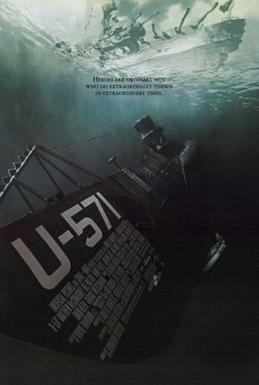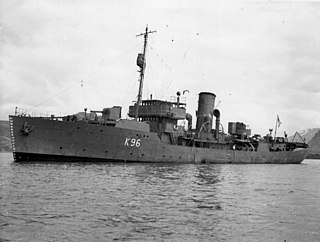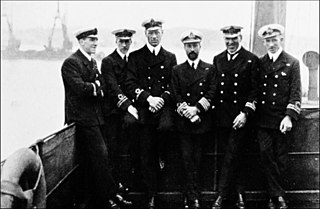
German submarine U-110 was a Type IXB U-boat of Nazi Germany's Kriegsmarine that operated during World War II. She was captured by the Royal Navy on 9 May 1941 and provided a number of secret cipher documents to the British. U-110's capture, later given the code name "Operation Primrose", was one of the biggest secrets of the war, remaining so for seven months. President Franklin D. Roosevelt was only told of the capture by Winston Churchill in January 1942.

U-571 is a 2000 submarine film directed by Jonathan Mostow from a screenplay he co-wrote with Sam Montgomery and David Ayer. The film stars Matthew McConaughey, Bill Paxton, Harvey Keitel, Jon Bon Jovi, Jake Weber and Matthew Settle. The film follows a World War II German submarine boarded by American submariners to capture her Enigma cipher machine.

The Battle of the Atlantic, the longest continuous military campaign in World War II, ran from 1939 to the defeat of Nazi Germany in 1945, covering a major part of the naval history of World War II. At its core was the Allied naval blockade of Germany, announced the day after the declaration of war, and Germany's subsequent counter-blockade. The campaign peaked from mid-1940 through to the end of 1943.

Captain Frederic John Walker, was a British Royal Navy officer noted for his exploits during the Second World War. Walker was the most successful anti-submarine warfare commander during the Battle of the Atlantic, and was known popularly as Johnnie Walker.

Admiral Sir Max Kennedy Horton, was a British submariner during the First World War and commander-in-chief of the Western Approaches in the later half of the Second World War, responsible for British participation in the Battle of the Atlantic.

USS Hunt (DD-194) was a Clemson-class destroyer in the United States Navy following World War I. She also served in the United States Coast Guard, as USCGD Hunt (CG-18). She was later transferred to the Royal Navy as HMS Broadway (H90).

HMS Bulldog (H91) was a B-class destroyer built for the Royal Navy (RN) between 1929 and 1931. Initially assigned to the Mediterranean Fleet, she transferred to the Home Fleet in 1936. During the Spanish Civil War of 1936–1939, the ship spent considerable time in Spanish waters, enforcing the arms blockade imposed by Britain and France on both sides of the conflict. Bulldog saw service throughout World War II on convoy escort duty during the Battle of the Atlantic and in the Arctic. Her most notable actions were the capture of an Enigma machine and codebooks from the German submarine U-110 in 1941, sinking another German submarine in 1944 and taking the surrender of the German garrisons on the Channel Islands on 9 May 1945. Surplus after the war, she was broken up for scrap in 1946.

HMS Graph was a German Type VIIC U-boat captured and recommissioned by the British Royal Navy during World War II.

HMS Arbutus was a Flower-class corvette of the Royal Navy, which was active during the Second World War. She was a successful escort vessel, and took part in the destruction of two U-boats during the Battle of the Atlantic. Arbutus was sunk in the North Atlantic in February 1942.

HMS Aylmer was a Captain-class frigate of the Royal Navy that served during World War II. The ship was named after Matthew Aylmer, commander of HMS Royal Katherine at the Battle of Barfleur in 1692 during the War of the Grand Alliance.

HMS Nigeria was a Fiji-class light cruiser of the Royal Navy completed early in World War II and served during that conflict. She was named after the British colony of Nigeria.
Lieutenant Francis Anthony Blair Fasson,, known as Tony Fasson, was a Royal Navy officer. He was posthumously awarded the George Cross "for outstanding bravery and steadfast devotion to duty in the face of danger" when on 30 October 1942 in action in the Mediterranean Sea he captured codebooks vital for the breaking of the German naval "Shark" Enigma cipher from the sinking German submarine U-559.

Fritz-Julius Lemp was a captain in the Kriegsmarine during World War II and commander of U-28, U-30 and U-110.

Vice Admiral Sir Peter William Gretton was an officer in the Royal Navy. He was active in the Battle of the Atlantic during the Second World War, and was a successful convoy escort commander. He eventually rose to become Fifth Sea Lord and retired as a vice admiral before entering university life as a bursar and academic.

OB 318 was a North Atlantic convoy which ran during the Battle of the Atlantic in World War II. During Operation Primrose Royal Navy convoy escorts HMS Bulldog, Broadway and Aubrietia captured U-110 with an intact Enigma machine and a wealth of signals intelligence, which led to the Allied breakthrough into cracking the German naval Enigma code.

Erhard Maertens or Eberhard Maertens was a German Vizeadmiral of the Kriegsmarine during World War II. From 16 June 1941 to 5 May 1943, he was Chief of Office of Naval Intelligence, Naval War Command in the Oberkommando der Marine. Maertens was known for underestimating British intelligence, and specifically, overrating the security of the Naval Enigma cipher machine. In 1941, he held a naval enquiry into the strength of Naval Enigma security after the capture of U-boat U-570, and attributed all the suspicious losses in U-boats at the time to the British Huff-Duff. In the second enquiry, ordered by the Commander-in-Chief of the Navy Karl Dönitz, in May 1943, he investigated a number of areas, which exculpated Enigma security in the end, for the second time, incorrectly blaming British 9.7 centimetre centimetric radar for the massive losses in U-boats by mid 1943.

HMS Aubrietia (K96) was a Flower-class corvette built for the Royal Navy (RN) from 1941-1946. She was active as a convoy escort in the Atlantic and Mediterranean. In May 1941, Aubrietia sighted and depth charged the German submarine U-110, leading to its capture and the seizure of a German Naval Enigma and its Kurzsignale code book.
HMS Aubrietia was one of 12 Aubrietia-class sloops completed for the Royal Navy and was launched in 1916. During World War I, she functioned as a Q-Ship and served under the name Q.13, also taking the names Kai, Winton and Zebal. Aubrietia was part of the 1st Sloop flotilla, based in Queenstown and subsequently, the 3rd Sloop Flotilla in the North Sea.

HMS Sunflower was a Flower-class corvette of the Royal Navy. She served during the Second World War.

Captain Cedric Naylor was a Royal Navy officer of the First and Second World Wars. Naylor was a merchant seaman before joining the Royal Naval Reserve on the outbreak of the First World War. In November 1915 he was posted as first lieutenant to HMS Penshurst, a Q-ship, a warship disguised as a merchant vessel intended to fool German U-boats into surfacing so they could be sunk. Naylor received the Distinguished Service Cross for his part in the sinking of SM UB-19 on 30 November 1916 and a bar for further operations in February and March 1917. Naylor was granted temporary command of Penshurst after its captain was incapacitated in June and the next month damaged a submarine, for which he was awarded the Distinguished Service Order. Further distinguished service in the following months saw him receive a bar to the medal and a transfer to the Royal Navy. Naylor was hunting for SM U-110 on Christmas Eve 1917 and Penshurst was struck by a torpedo fired by the submarine. Despite suffering heavy damage Naylor remained onboard with two gun crews, hoping the U-boat would surface to finish off the ship. When U-110 surfaced it was hit twice and damaged before Penshurst sank. Naylor survived and was awarded a second bar to his DSO. He commanded the sloop Polyanthus for the remainder of the war.
















